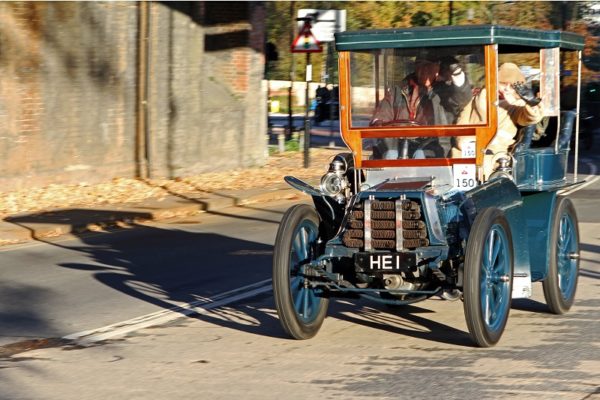
Brothers John and Clive Boothman are Napier people, and they have responded to the recent Slider and posts on Napiers with true enthusiasm and generosity. They own a 1902 12 h.p. Napier whose history is known almost from new – and they have sent us some wonderful photographs. The headline colour picture shows the car at Coulsdon on the 2016 London to Brighton Run.
John and Clive have also sent us the specification and brief history of their car, with a short history of the Napier company. We reproduce all three here, as they have written them.
D. Napier & Son
Of Scottish ancestry and the son of a blacksmith, David Napier established his engineering business in London in the early 1800’s. He and his son James made printing presses and, as the century progressed, stamp perforating, coin weighing, bullet making and a range of other precision machines from their factory in Vine Street, Lambeth.
When James died in 1895 his 25 year old son Montague took on the business. In 1899 Montague was introduced to fellow keen cyclist S. F. Edge, who commissioned Montague to make improvements to his Panhard et Levassor car. An arrangement then developed whereby Montague made cars and Edge sold them. One of their earliest cars gained a silver medal in the 1900 1,000 Mile Trial: Edge recognised the value of publicity from sporting successes. In 1902 he won the Gordon Bennett trophy on a Napier, the first international motor racing success by a British car.
Napier went on to make over 5,000 cars up to the First World War, including the first commercially successful 6-cylinder car. Car production continued until 1924 but, post war, the attentions of the firm turned to aero engines,
Specification of the Boothman car
| Model type: D45
Engine: 4-cylinder Capacity: 2,523cc Valves: Automatic inlet, mechanical exhaust Ignition: Trembler coils Gearbox: 4 forward + reverse Final drive: chain Top speed: 40 mph Registration no. HE 1 Chassis no. 423 Engine no. 202 VCC Dating certificate 190 Body: Rear entrance tonneau by Mulliner of Northampton Current owners: John & Clive Boothman |
A brief history of HE 1
The first owner was Richard Key Micklethwait of Ardsley House, Barnsley, Yorkshire. He owned substantial lands around Barnsley, including a brickworks, quarry and interests in local collieries. He employed as his chauffeur the son of his coachman, a very young George H. Eyre. In around 1905, Richard Micklethwait and his wife moved to Zeals House in Wiltshire for health reasons. The picture below shows a young George Eyre at the wheel after the move to Wiltshire.
This picture of George Eyre was taken at Zeals.
Squire Micklethwait died in 1908 and the car stayed down south whilst Eyre returned to Barnsley and set up a successful garage business with his brother, Hubert. In 1934 Eyre tracked the Napier down in Gillingham, Dorset (only some 4 miles from Zeals) and purchased it, campaigning it actively on VCC rallies at home and abroad until his death in the early 1950’s.
The car was then taken on by his nephew, James Victor Medlam, who continued to rally it.
The car was purchased by Thomas Boothman in 1979 and has remained in the Boothman family ever since. Bodily and mechanically restored, it remains much as it left the Napier factory. The car has taken part in a number of UK and international events, including the 1000 Mile Trial re-enactment in 2000 and rallies in Switzerland and France, as well as being a regular participant on the Brighton Run.
Now here are some more pictures, with additional details:
In front of the coach house at Zeals, partially dismantled with chauffeur and mechanic. An early De Dion accompanies it. Clive Boothman has visited the house and tells us that the coach house remains much as it was.
The Napier with an array of trophies
Outside the Eyre premises.
On the street in 1935. The car is wearing a trade plate (047HE). George Eyre is taking the Vicar of Dodworth for a trip down the High Street. (Dodworth is a suburb of Barnsley, where the Eyre business was located).
We are most grateful to John and Clive for allowing us to publish all this information and delightful pictures. We hope you have enjoyed the story as much as we have.








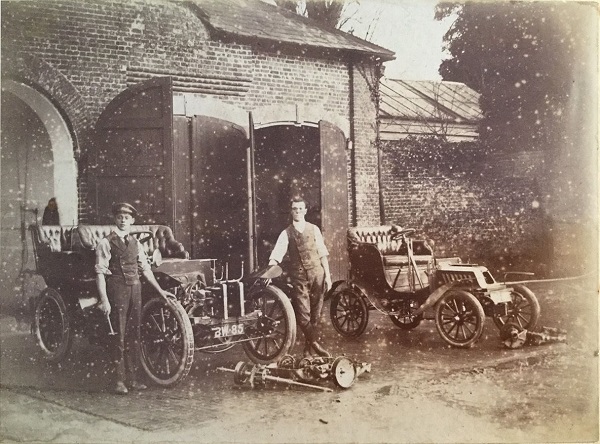
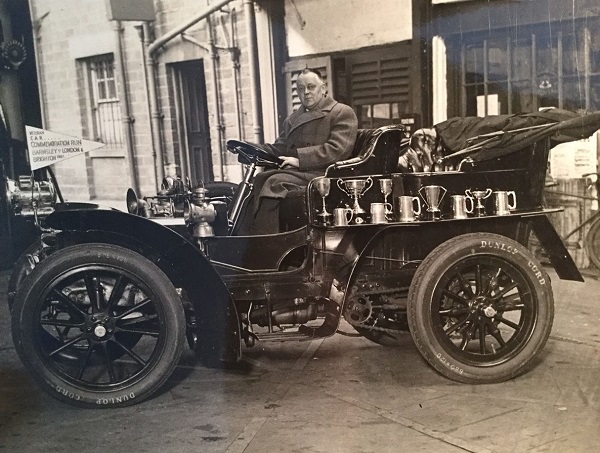
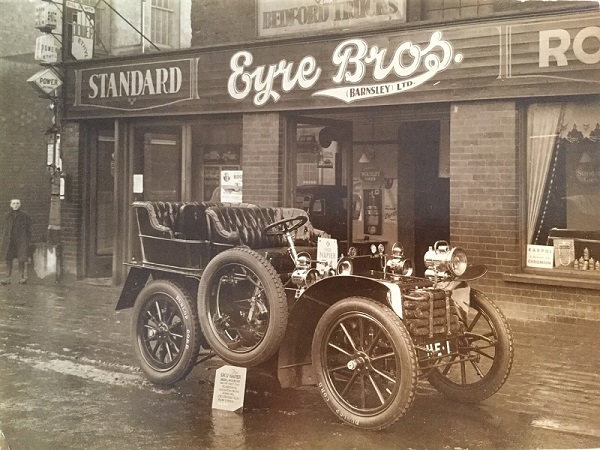
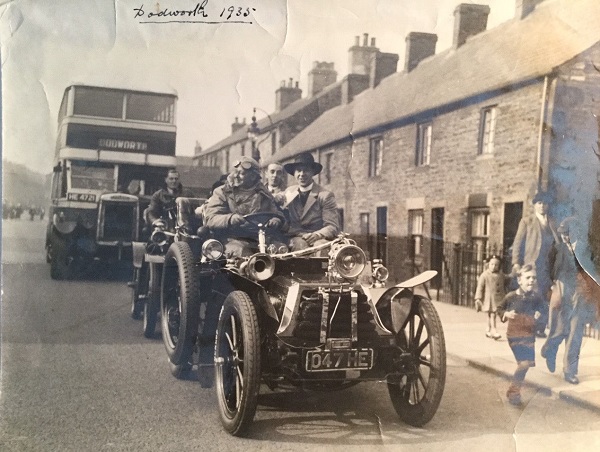
My name is Paul Medlam. My father is James Victor Medlam (known as Victor), mentioned in the article above. You have mentioned that my father ‘took on’ the car. This is incorrect. My father inherited the ownership of the car from his uncle George Eyre. The car was always known as HE1 in the family. My father also drove it regularly before his uncle died, as George owned 2 veteran cars and my father used to drive one or other of the cars on early 1950s rallies. One of the most interesting photos of the car that I have which is not included above showed my father driving the car with the very well known at the time comedian Bob Monkhouse and two attractive young ladies in the back at a rally in the late 1950s. The car was never trailered during my father’s ownership (he couldn’t afford that) and I remember long journeys all around the country at a steady 30mph on motorways. My father owned the car until Mr Boothman bought it from him in 1979. The place he garaged and worked on the car was being taken away and my father could not afford to keep it elsewhere so had to sell. I was 15 at the time in 1979 and was there the day Mr Boothman and his son came to see the car and drove it for the first time.
During the 1960s the car developed serious engine problems (failed big end bearings and cracked block). My father was a motor mechanic and was just an ordinary working man not a businessmen like the Eyres and the Boothmans. Over a period of 6 years he begged, borrowed and made the parts required for the repair and did all the work himself working in a shallow pit at the garage. Back breaking work. Upon its final repair I remember as a child taking my first ever ride in the car with my father and grandmother on its first short journey after being laid up for years. Without my father’s work the car would not exist.
On many subsequent veteran car rallies including the annual Harrogate Rally and Hull to Scarborough Rally the car and my father won many awards. I still have all the cups and badges my father won including a large silver candle arbour from one rally. He was particularly adept at what were known as ‘Timed Runs’, regulation rally’s where you had to reach checkpoints at specific pre-stated times. This was all the more remarkable as HE1 was one of the few cars on the rally’s that did not have an original or retrofitted speedo. Speed was all guessed by my father on how the car felt. My father was a real ‘motor man’.
His constant companion on most rallies was my uncle Geoff Stables, his brother in law. Geoff was always the one who had to swing the starting handle while my dad worked his magic pulling and pushing various controls. They used to get soaking wet with no hood or windscreen whilst my mum and me hid in the back under the tonneau cover. They had a very close bond and were both gentlemen in both senses of the word. Geoff passed away recently and I was lucky enough to see him just before. Geoff loved the car as much as my dad did. Before and after my dad died in 2013 he and my Aunty Joyce compiled lots of documented history of HE1 pre Mr Boothman. That has now passed to me as the last link between the Medlams and HE1.
Upto 1979 the car was always described as ‘all original’ in veteran car rally brochures. The bodywork and chassis were original and the only changes were the upholstery refreshed long ago and the work my father had had to carry out to the drivetrain. Therefore we knew Mr Boothman intended to carry out restoration work on the car. Whilst I was there in 1979 Mr Boothman said when that was complete he would enter the car in the Brighton run and bring my father down to see it. However my father never did hear anything further from Mr Boothman and I know that did disappoint him a little.
However there was one postscript. About 10 years after he sold the car (when my father was then in his 60s) he received a phone call from a restorer in the midlands who was working on the car. My dad’s contact details had been passed on by Mr Boothman. They were having some problems with some particular issue and could he please come down, look at the car and help them. My father being as he was travelled down and back from Yorkshire to Birmingham in one day. Put on his overalls, got under the car and solved their problem. He never minded the inconvenience and was glad to see the car again. However it was always a sore point with my mum as during the visit to the restorer they were both not even offered as much as a cup of tea, my mum was not happy!
I think it’s important that my father’s contribution to the history of HE1 is correctly recorded.